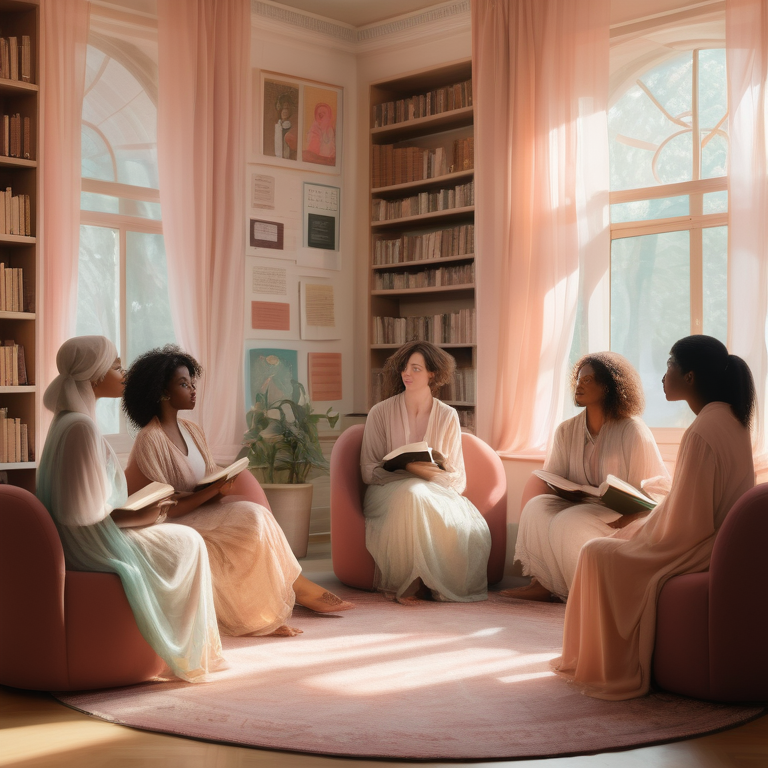Exploring Feminist Perspectives in Literature

Key Highlights
- Feminist literary criticism examines the representation of women in literature and the ways in which gender roles and power dynamics are portrayed.
- Early feminist works by writers like Mary Wollstonecraft and the Brontë sisters challenged traditional notions of women’s roles in society.
- Virginia Woolf and Simone de Beauvoir made significant contributions to feminist literature with their exploration of female identity and the limitations placed on women.
- Feminist perspectives in literature have expanded to include intersectionality, examining how race, class, and gender intersect and impact women’s experiences.
- Feminist literary criticism has provided valuable insights into canonical texts and has paved the way for more diverse and inclusive narratives in literature.
- Publishers and editors play a crucial role in promoting feminist literature and overcoming the challenges faced by feminist authors in the publishing industry.
Introduction
Feminist perspectives have had a profound impact on literature, challenging traditional gender roles and power dynamics within literary works. Feminist literary criticism emerged as an academic discipline in the 1960s and 1970s as part of the broader feminist movement. It seeks to examine and challenge the representation of women in literature, as well as explore the ways in which gender shapes our understanding of literary texts.
Feminist literary criticism has evolved over time, with different waves of feminism influencing the approach to analyzing literature. Early feminist works by writers such as Mary Wollstonecraft and the Brontë sisters challenged the limited roles assigned to women in society. These writers questioned the social and cultural expectations placed on women and offered alternative visions of female agency and empowerment.
The Evolution of Feminist Thought in Literature
The evolution of feminist thought in literature can be traced back to the 19th century when the first wave of feminism emerged. This wave focused on gaining legal and political rights for women, and feminist thinkers began to critique the portrayal of women in literature. They highlighted the ways in which male novelists often marginalized or demeaned female characters.
In the 20th century, second wave feminism emerged, and feminist literary criticism became more prominent. This wave of feminism sought to address broader issues of gender inequality and challenged the social and cultural norms that perpetuated patriarchy. Feminist theorists like Virginia Woolf and Simone de Beauvoir explored the construction of gender identities and the impact of societal expectations on women’s lives.
Early Feminist Works and Their Impact
Mary Wollstonecraft’s “A Vindication of the Rights of Woman” is often considered one of the earliest feminist works. In this seminal text, Wollstonecraft argued for equal educational opportunities for women and challenged the prevailing notion that women were intellectually inferior to men. Her work paved the way for future feminist thinkers and writers.
In English literature, the works of women writers like Jane Austen and the Brontë sisters were groundbreaking in their exploration of female independence and agency. Austen’s novels, such as “Pride and Prejudice” and “Emma,” offered nuanced portrayals of women navigating societal expectations and the limitations imposed on them. The Brontë sisters, with novels like “Jane Eyre” and “Wuthering Heights,” depicted strong-willed and independent female characters who defied societal norms.
These early feminist works laid the foundation for feminist literary criticism and challenged the prevailing stereotypes and expectations placed on women in literature.
Transitioning Voices: From the 19th to the 21st Century
Virginia Woolf and Simone de Beauvoir emerged as influential voices in the transition from the 19th to the 20th century, challenging traditional notions of femininity and the limitations placed on women in society.
Woolf’s works, such as “To the Lighthouse” and “Mrs. Dalloway,” utilized the stream of consciousness technique to explore the inner lives of female characters. Her writing examined the ways in which societal restrictions affected women’s experiences and identities. In her essay “A Room of One’s Own,” Woolf argued for the importance of women having financial independence and creative freedom to fully explore their potential as writers.
Simone de Beauvoir’s “The Second Sex” is a foundational text in feminist theory. De Beauvoir analyzed the social and cultural construction of gender and argued that women were defined and oppressed by their relationship to men. Her work challenged the notion of female inferiority and advocated for women’s liberation and equality.
Key Feminist Writers and Their Contributions
- Mary Wollstonecraft: Advocate for women’s rights and author of “A Vindication of the Rights of Woman.”
- Virginia Woolf: Explored female identity and the limitations placed on women in society in works like “To the Lighthouse” and “A Room of One’s Own.”
- Simone de Beauvoir: Examined gender roles and the social construction of femininity in “The Second Sex.”
Virginia Woolf and the Stream of Consciousness
Virginia Woolf is often associated with the literary technique known as stream of consciousness. Through this technique, Woolf sought to capture the inner thoughts and experiences of her characters, particularly female characters. This narrative style allowed for a more nuanced exploration of female subjectivity and challenged traditional linear storytelling.
In her essay “A Room of One’s Own,” Woolf argued that women needed both financial independence and physical space in order to fully develop their creative potential. She highlighted the ways in which societal expectations and limited opportunities for women hindered their ability to engage in literary pursuits. Woolf’s feminist literary criticism and exploration of female identity continue to resonate with readers and scholars today.
Simone de Beauvoir and the Second Sex
Simone de Beauvoir’s “The Second Sex” is a seminal work in feminist theory. In this influential text, de Beauvoir examined the social, cultural, and historical construction of femininity. She argued that women were defined and oppressed by their relationship to men and called for the liberation of women from the constraints of traditional gender roles.
De Beauvoir’s analysis of the second sex has had a profound impact on feminist theory and has sparked debates about the nature of gender and the ways in which women are marginalized in society. Her work continues to be a cornerstone of feminist literary criticism and has contributed to the development of French feminism.
Feminism and Genre: Breaking Boundaries
- Feminist literature has transcended traditional genres and challenged the boundaries imposed on women’s writing.
- Poetry has been a powerful form of feminist expression, allowing women to explore their experiences and perspectives.
- Feminist science fiction has offered a platform for imagining new worlds and exploring gender roles and power dynamics.
Poetry as a Form of Feminist Expression
Poetry has long been a form of feminist expression, allowing women writers to explore their experiences, emotions, and perspectives. It has provided a platform for challenging societal norms and advocating for gender equality. Some key themes in feminist poetry include the exploration of female identity, the body, sexuality, and the intersectionality of gender with race and class.
- Women writers like Sylvia Plath, Adrienne Rich, and Audre Lorde have made significant contributions to feminist poetry.
- These poets have used their work to challenge patriarchal structures, confront societal expectations, and give voice to women’s experiences.
- Feminist poetry has been instrumental in shaping feminist literary theory and providing a platform for marginalized voices.
Feminist Science Fiction: Imagining New Worlds
Feminist science fiction, also known as speculative fiction, has been an important genre for exploring gender roles and power dynamics. It offers a space for imagining alternative futures and challenging traditional notions of gender and identity.
- Writers like Ursula K. Le Guin, Octavia Butler, and Margaret Atwood have made significant contributions to feminist science fiction.
- Feminist science fiction often explores themes of reproductive rights, gender equality, and the impact of technology on society.
- By envisioning new worlds and societies, feminist science fiction allows for a critique of existing power structures and offers possibilities for change.
Feminism and Intersectionality in Literature
- Intersectionality examines how race, class, and gender intersect and shape women’s experiences within literature.
- Black feminism has been instrumental in highlighting the unique challenges faced by women of color and advocating for their representation in literature.
- Contemporary feminist literature includes diverse voices and perspectives, including those of transgender women and individuals of different sexual orientations.
Race, Class, and Gender: Intersecting Identities
Intersectionality is a key concept in feminist literary criticism, examining how race, class, and gender intersect and shape women’s experiences and identities. It recognizes that women’s experiences are not universal, but are influenced by multiple social, cultural, and historical factors.
Black feminism has been particularly influential in highlighting the unique challenges faced by women of color and advocating for their representation in literature. Writers like bell hooks have explored the intersections of race, class, and gender in their work and have called for more inclusive and diverse narratives.
Contemporary Voices in Intersectional Feminist Literature
Contemporary feminist literature embraces intersectionality, giving voice to a diverse range of experiences and identities. It includes the perspectives of transgender women, individuals of different sexual orientations, and those from marginalized communities.
- Writers like Roxane Gay, Chimamanda Ngozi Adichie, and Carmen Maria Machado have made significant contributions to intersectional feminist literature.
- These writers explore the intersections of gender, race, sexuality, and class, challenging societal norms and advocating for greater inclusivity.
- Intersectional feminist literature offers a more comprehensive understanding of the complexities of identity and the ways in which different forms of oppression intersect.
Feminist Literary Criticism and Theory
- Feminist literary criticism examines the representation of women in literature and the ways in which gender and power dynamics are portrayed.
- Key concepts in feminist literary analysis include the exploration of female subjectivity, the critique of patriarchal structures, and the examination of gender roles.
- Feminist critics like Elaine Showalter, Luce Irigaray, and Julia Kristeva have made significant contributions to feminist literary theory.
Key Concepts in Feminist Literary Analysis
Feminist literary analysis encompasses a range of key concepts that inform the examination of literature through a feminist lens. These concepts include:
- Female subjectivity: Feminist critics explore the representation of women and their experiences in literature, challenging traditional gender roles and stereotypes.
- Patriarchal structures: Feminist literary criticism examines how power dynamics and social structures perpetuate gender inequality and marginalize women.
- Gender roles: Analysis of gender roles in literature highlights the ways in which societal expectations and cultural norms shape women’s identities and opportunities.
Feminist critics like Elaine Showalter, Luce Irigaray, and Julia Kristeva have made significant contributions to feminist literary theory. These theorists have expanded the field of feminist literary criticism and provided valuable insights into the representation of women in literature.
Applying Feminist Criticism to Canonical Texts
Feminist criticism has challenged the traditional interpretations of canonical texts and examined their portrayal of women and gender dynamics. By applying a feminist lens to these texts, feminist critics have shed light on the ways in which women are marginalized or misrepresented within literature.
- A text table can be created to compare the interpretations of canonical texts through feminist criticism. For example:
|
Text |
Traditional Interpretation |
Feminist Interpretation |
|
“Pride and Prejudice” |
A love story and social commentary |
Depiction of women’s limited options and the constraints imposed by society |
Feminist critics like Julia Kristeva have explored the intersections of language, gender, and power in canonical texts. Their analysis has challenged the dominant narratives and provided alternative perspectives on these works of literature.
The Role of Publishers and Editors
- Publishers play a crucial role in promoting feminist literature and ensuring diverse voices are represented.
- The publishing industry in New York has been a hub for feminist literature and feminist publishers.
- Feminist publishers face challenges such as sexual harassment and gender stereotypes within the industry.
Promoting Feminist Literature in the Publishing Industry
Publishers play a crucial role in promoting feminist literature and ensuring that diverse voices are represented in the publishing industry. They have the power to shape the literary landscape and influence the narratives that are shared with readers.
New York has been a hub for feminist literature and feminist publishers. The city’s vibrant literary scene has provided a platform for feminist voices and has facilitated the publication of feminist works.
However, feminist publishers also face challenges within the industry. Sexual harassment, gender stereotypes, and a lack of representation in top positions are some of the obstacles that feminist publishers must navigate. Despite these challenges, feminist publishers continue to make significant contributions to the literary world by amplifying marginalized voices and promoting feminist literature.
Challenges Faced by Feminist Publishers
Feminist publishers face a range of challenges in the publishing industry. These challenges include:
- Sexual harassment: The publishing industry, like many other industries, has been plagued by issues of sexual harassment. This can create a hostile and unsafe environment for women in the industry, affecting their ability to publish and promote feminist literature.
- Gender stereotypes: Gender stereotypes and bias can limit the opportunities available to feminist publishers. In a male-dominated industry, women may face barriers to advancement and may struggle to have their voices and perspectives heard.
- Lack of representation: Women and marginalized voices are often underrepresented in top positions within the publishing industry. This lack of representation can perpetuate biases and limit the diversity of voices and perspectives in published works.
Despite these challenges, feminist publishers continue to be at the forefront of promoting feminist literature and creating spaces for marginalized voices to be heard.
Conclusion
Feminist perspectives in literature have evolved significantly, shaping our understanding of gender, identity, and power dynamics. From early feminist works to contemporary voices, feminist writers have challenged norms and boundaries across genres. Intersectionality has further enriched these narratives by exploring the complexities of race, class, and gender. Through feminist literary criticism, canonical texts are re-examined, offering fresh insights and interpretations. Publishers play a crucial role in promoting feminist literature, despite facing challenges. By delving into feminist themes, works, and theories, we gain a deeper appreciation of literature’s role in reflecting and influencing societal values. Let’s continue this conversation by sharing insights on social media to amplify diverse voices and perspectives.
Frequently Asked Questions
What are some common themes found in feminist literature?
Themes commonly found in feminist literature include the exploration of gender roles, the portrayal of female characters breaking free from societal expectations, and the critique of patriarchal power structures.
How have feminist perspectives influenced the literary world?
Feminist perspectives have had a significant impact on the literary world by challenging traditional gender roles, highlighting the experiences of women, and encouraging the inclusion of diverse voices. They have enriched literary analysis and created space for marginalized writers and perspectives.
Can you provide examples of well-known feminist authors and their works?
Well-known feminist authors include Virginia Woolf, who explored female subjectivity and the limitations placed on women in works like “To the Lighthouse” and “A Room of One’s Own.” Simone de Beauvoir’s “The Second Sex” is a seminal work in feminist theory. Jane Austen challenged societal expectations and depicted strong-willed female characters in novels like “Pride and Prejudice” and “Emma.”
How can feminist perspectives enhance our understanding of literature and society?
Feminist perspectives provide a critical lens through which we can analyze literature and society. They challenge the patriarchal structures that shape our understanding of gender and power dynamics. Feminist perspectives offer a more nuanced and inclusive interpretation of literature and help us recognize the impact of gender inequality in society.





